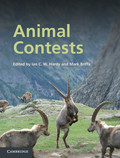Book contents
- Frontmatter
- Contents
- List of contributors
- Foreword
- Preface
- Acknowledgements
- Abbreviations
- 1 Introduction to animal contests
- 2 Dyadic contests: modelling fights between two individuals
- 3 Models of group or multi-party contests
- 4 Analysis of animal contest data
- 5 Contests in crustaceans: assessments, decisions and their underlying mechanisms
- 6 Aggression in spiders
- 7 Contest behaviour in butterflies: fighting without weapons
- 8 Hymenopteran contests and agonistic behaviour
- 9 Horns and the role of development in the evolution of beetle contests
- 10 Contest behaviour in fishes
- 11 Contests in amphibians
- 12 Lizards and other reptiles as model systems for the study of contest behaviour
- 13 Bird contests: from hatching to fertilisation
- 14 Contest behaviour in ungulates
- 15 Human contests: evolutionary theory and the analysis of interstate war
- 16 Prospects for animal contests
- Index
- References
8 - Hymenopteran contests and agonistic behaviour
Published online by Cambridge University Press: 05 June 2013
- Frontmatter
- Contents
- List of contributors
- Foreword
- Preface
- Acknowledgements
- Abbreviations
- 1 Introduction to animal contests
- 2 Dyadic contests: modelling fights between two individuals
- 3 Models of group or multi-party contests
- 4 Analysis of animal contest data
- 5 Contests in crustaceans: assessments, decisions and their underlying mechanisms
- 6 Aggression in spiders
- 7 Contest behaviour in butterflies: fighting without weapons
- 8 Hymenopteran contests and agonistic behaviour
- 9 Horns and the role of development in the evolution of beetle contests
- 10 Contest behaviour in fishes
- 11 Contests in amphibians
- 12 Lizards and other reptiles as model systems for the study of contest behaviour
- 13 Bird contests: from hatching to fertilisation
- 14 Contest behaviour in ungulates
- 15 Human contests: evolutionary theory and the analysis of interstate war
- 16 Prospects for animal contests
- Index
- References
Summary
Summary
The insect order Hymenoptera is speciose, diverse and common. Many wasps, bees and ants are well known for their ability, and propensity, to engage in agonistic interactions via biting and stinging (chemical injection), and may also interact using chemical deposition and volatile chemical release. Such behaviours are often exhibited during acquisition and defence of resources contested either by conspecifics or by allospecific hymenopterans. Here we examine the types of contests engaged in by social and non-social hymenopterans and highlight links between these and further aspects of evolutionary and applied biology. We first consider factors influencing the outcomes of contests between pairs of females over resources for reproduction. Studies of female–female contests in bethylids and several non-aculeate species of parasitoid wasps, especially scelionids, pteromalids and eupelmids, have addressed fundamental causes of the outcomes of contest interactions and have further linked contest behaviour to strategies of patch exploitation, clutch size and parental care. Further, we review links between the study of contest behaviour in parasitoids and their use as agents of biological pest control, particularly in terms of how contest behaviour may constitute intra-guild predation and influence strategic decisions to deploy single or multiple species of natural enemies. We then consider contests between males for access to mates, especially those engaged in by fig wasps and other wasps. Male–male contests are placed in the context of the evolution of alternative male morphs, mating systems, sex ratios and social behaviours. Finally, we return to female–female contests, this time examining them in the more complex context of the social Hymenoptera, in which both between-individuals (intra-colony) and between-group (inter-colony) contests occur.
Information
- Type
- Chapter
- Information
- Animal Contests , pp. 147 - 177Publisher: Cambridge University PressPrint publication year: 2013
References
Accessibility standard: Unknown
Why this information is here
This section outlines the accessibility features of this content - including support for screen readers, full keyboard navigation and high-contrast display options. This may not be relevant for you.Accessibility Information
- 39
- Cited by
